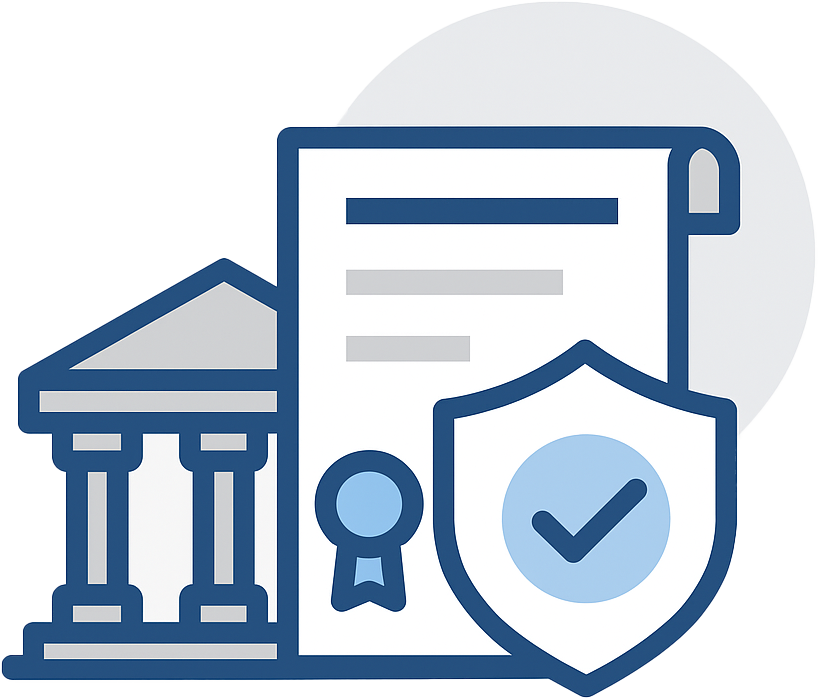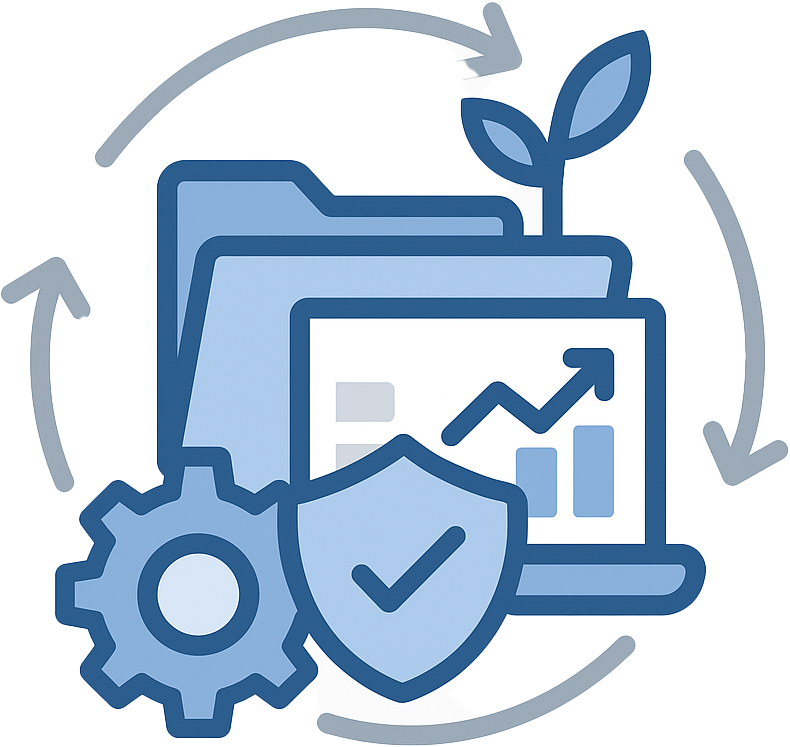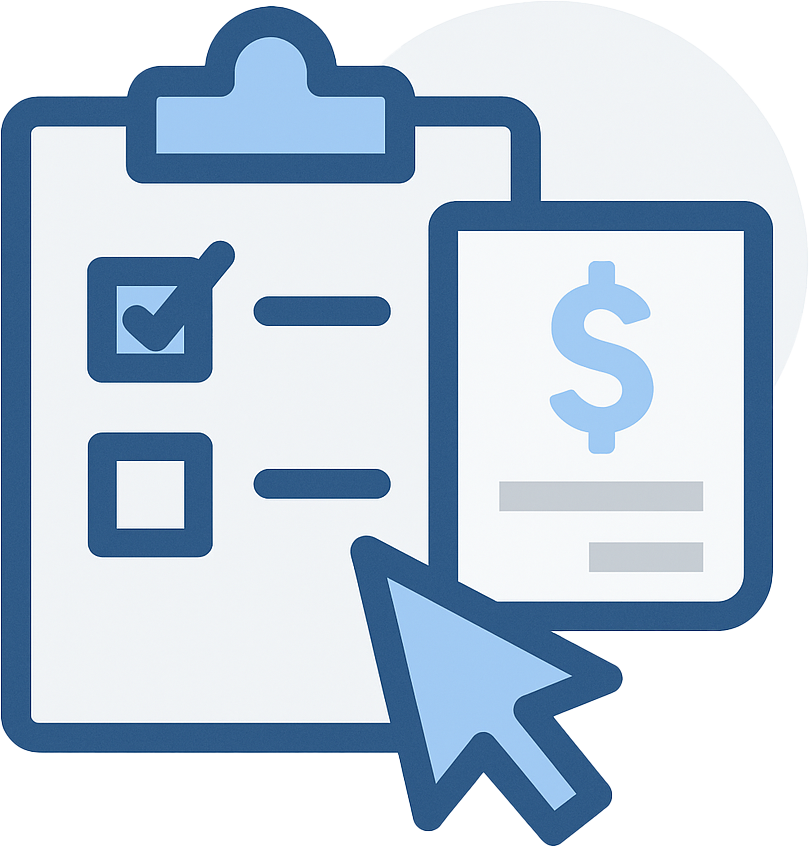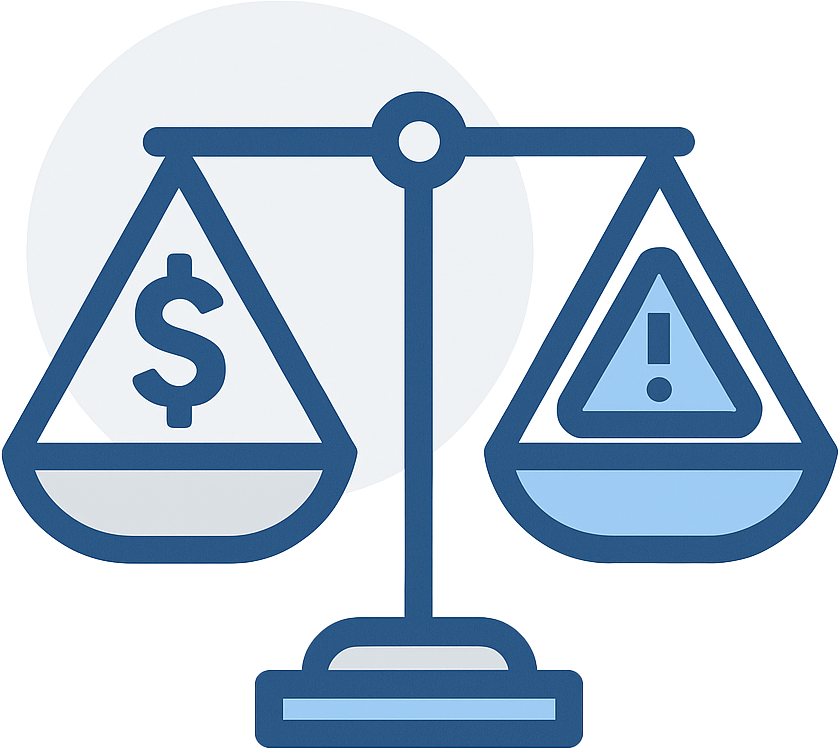Is Your Facility Really Compliant with Waste and Hazardous Waste Rules?
Are you confident your facility is fully compliant with state and federal waste regulations, especially hazardous waste? If there’s even a shred of doubt, you’re not alone. Maybe you’ve already gotten a warning, fine, or notice of violation. Maybe nothing’s happened yet, but something just doesn’t feel right.
We know this stuff can feel overwhelming and totally confusing. Honestly, how can there be this many rules about trash?! But there are - and if you’re the one responsible for getting it right, it can be a lot to carry.
That’s why we’ve pulled together this no-nonsense guide covering the most common questions we hear from facilities just like yours. We’ve done our best to make it as clear, complete, and practical as possible. If something’s still unclear - or if we missed a question that’s keeping you up at night - please reach out. We’re always happy to clarify, no pressure and no strings attached.
One quick note: This guide is written for waste generators (facilities that create waste onsite and may store it temporarily before sending it off for treatment or disposal). If you’re a transporter, landfill, incinerator, or treatment facility, this might not hit your specific rules, but we’re still glad to help if you reach out. Okay, let’s get into it.
Table of Contents
What Actually Counts as Waste?
Okay, let's start with the basics: a material becomes a waste when it’s no longer usable for its original purpose and you plan to get rid of it. That could mean tossing it in the trash, burning it, storing it indefinitely with no plan to use it, or sending it offsite for treatment or disposal.
Simple as that. It doesn’t matter if it’s solid, liquid, or gas. If you’re not using it and you’re not actively reclaiming it, it’s probably considered waste (and possibly regulated waste!).
This can include everything from the obvious (used solvents, oily rags, broken equipment, expired chemicals) to things most people don’t think twice about, like food wrappers, used wipes, or random junk piling up in a storage closet.
Who Regulates Waste? My State or the EPA?
Both. At the federal level, waste (especially hazardous waste) is regulated under the Resource Conservation and Recovery Act (RCRA), which is enforced by the U.S. EPA. But here’s the catch: states can run their own waste programs, and they’re allowed to go above and beyond the federal rules. And many do.
That means your facility has to follow both the federal baseline requirements and any additional rules your state enforces. Some states (like California, New York, and Washington) are known for having tougher hazardous waste laws than the EPA’s minimum standards. Bottom line: don’t assume federal compliance means you’re all set. You need to know your state’s specific requirements too.
Are There Different Types of Waste?
Absolutely, and knowing the difference is key to staying compliant. Waste generally falls into a few major categories:
- Solid Waste
Despite the name, this includes more than just dry or solid materials. It covers a wide range of discarded items - trash, scrap, packaging, household waste, and even some liquids and gases.
- Hazardous Waste
A subset of solid waste that’s flammable, corrosive, reactive, or toxic. If your waste has any of these properties it’s likely considered hazardous and comes with stricter handling requirements.
- Universal Waste
These are more common, lower-risk hazardous wastes like batteries, fluorescent lamps, and mercury thermostats. The rules are a bit more flexible here, to encourage proper recycling and disposal.
- Other Regulated Wastes
Depending on your state, you might also need to follow special rules for medical waste, used oil, electronic waste (e-waste), and other specific waste streams.
Knowing exactly what kind of waste you generate is step one. Everything else (labeling, storage, transport, reporting) flows from that.

How Do I Know if a Waste Is Hazardous?
Good question, and the answer isn’t always obvious. There are two main types of hazardous waste:
- Listed hazardous waste: These are specific waste types named by the federal government. If your waste is on the list, it’s hazardous. Simple as that.
- Characteristic hazardous waste: These aren’t listed by name, but they’re hazardous because they’re flammable, corrosive, reactive, or toxic. If your waste meets one of those traits, it qualifies.
So how do you know which you have? If you’re the waste generator, it’s your legal responsibility to find out. No one else’s.
If it’s listed, that’s relatively easy to check. But if it’s not, and you’re unsure, you’re required to do a waste characterization to determine if it’s hazardous. You can’t assume. Guessing wrong can lead to violations, fines, and environmental consequences.
And while your waste hauler may be helpful, the liability doesn’t fall on them, it falls on you. If you're not sure, reach out to us to find out if you generate hazardous waste.
Common Operations and the Hazardous Waste They Generate
Here are typical facility activities that often produce regulated waste, and what that waste might be:
- Parts cleaning / degreasing → Spent solvents (acetone, MEK, toluene), solvent sludge
- Painting / coating → Paint waste, solvent rags, used filters, spray booth residue
- Equipment maintenance → Used oil, oily rags, spent cleaners, contaminated PPE
- Laboratory work / R&D → Expired reagents, chemical mixtures, sample prep waste
- Plating / metal finishing → Cyanide solutions, acid baths, heavy metal sludge
- Battery handling → Lead-acid batteries, lithium battery waste
- Lighting / electrical → Mercury lamps, ballasts, capacitors
- Pesticide or chemical storage → Expired or off-spec product, spill cleanup material
- Cleaning / janitorial → Disinfectants, aerosols, mop water with hazardous residue
If you do any of the above, you’re likely generating hazardous waste - whether you realize it or not!
I Don’t Generate Hazardous Waste... Do I Still Need a Program?
Legally? Probably not. But strategically? Maybe. If your facility doesn’t generate hazardous waste, you’re likely not required to register as a generator or follow hazardous waste regulations. That’s great news. But that doesn’t mean you should ignore waste management altogether. Many companies still benefit from a structured waste program, especially if you’re:
- Pursuing zero-waste certification
- Looking to reduce disposal costs
- Interested in launching a recycling or composting initiative
- Focused on corporate sustainability or ESG goals
- Concerned about public perception or customer expectations
A proactive waste program (even if not required) can improve efficiency, cut costs, and show stakeholders you’re serious about responsible operations. RMA helps companies design simple, effective waste programs that go beyond compliance to support real business goals. Whether you’re aiming for zero waste, greener operations, or just more control, we’ve got your back - just reach out!

What Are the Hazardous Waste Generator Categories?
Your responsibilities as a hazardous waste generator depend on how much you generate per month. Here’s a quick breakdown of the three categories:
Very Small Quantity Generators (VSQGs)
- Generate 100 kg or less (about 220 pounds) of hazardous waste per month
- May not accumulate more than 1,000 kg (2,200 pounds) onsite at any time
- Often not required to notify the EPA (though some states do require registration)
- Fewer requirements overall, but you still must dispose of waste properly and can’t stockpile indefinitely
Small Quantity Generators (SQGs)
- Generate more than 100 kg but less than 1,000 kg (220–2,200 pounds) per month
- Can store waste onsite for up to 180 days (or 270 days if shipping over 200 miles)
- Must have an EPA ID number, train employees, and follow specific storage and accumulation rules
- Required to maintain records and inspect storage areas regularly
Large Quantity Generators (LQGs)
- Generate 1,000 kg or more (2,200+ pounds) in any single month
- Also includes anyone generating more than 1 kg of acute hazardous waste (like P-listed waste)
- Must ship waste offsite within 90 days
- Required to follow strict standards for labeling, storage, inspections, and emergency planning
- Must file biennial reports, maintain a full contingency plan, and typically face more frequent inspections
The bottom line? Know your monthly volumes. If you’re near a threshold, reassess your status and be proactive - crossing a category line can dramatically change your obligations.
Do All Waste Generators Have to Register?
Not all of them, but some definitely do. Whether or not you need to register depends on how much hazardous waste you generate each month. That’s why it’s so important to track your waste volumes accurately and have documentation to back up your numbers.
Based on how much you generate, you’ll fall into one of three hazardous waste generator categories above and your registration and reporting requirements will vary accordingly.
If your facility doesn’t generate hazardous waste, most states don’t require you to register. But if you do? You’d better know your category, because the rules change fast once you cross certain thresholds.
Can I Change My Generator Status?
Yes, and if you're in the wrong category, you should! Your hazardous waste generator status isn’t fixed forever. It’s based on how much hazardous waste you generate in a given calendar month, and that number can fluctuate. There are two reasons to reassess:
- You might be able to lower your category.
If you’ve reduced waste through better processes, switched to non-hazardous materials, or just generate less than you used to, you may qualify for a lower generator category. That means fewer rules, less paperwork, and lower compliance costs.
- Or you may need to increase it.
If you're currently categorized too low (for example, claiming VSQG status while regularly exceeding quantity limits) you're risking serious penalties for non-compliance.
So, if your monthly volumes have changed, or you're unsure which category you fall into, check your waste totals and adjust accordingly. And if you're totally confused, don't sweat it! RMA can help you calculate your generation rates, reclassify your status, and document everything to stay compliant.

What's the Deal with Biennial Reports?
The Biennial Report is a detailed summary of your hazardous waste activity over the past two years, and is required for all facilities categorized as Large Quantity Generators (LQGs). It’s submitted to the EPA or your state agency and must include:
- Total quantities and types of hazardous waste generated
- How the waste was managed
- Where it was sent
If you’re an LQG and skip this step (or submit incomplete or inaccurate data) you could face significant fines. If you’re not sure how to go about preparing a biennial report, reach out to us at RMA - we can help!
What Should Be in a Contingency Plan, and Who Can Develop One?
If your facility is a Large Quantity Generator (LQG) of hazardous waste, you're required to have a written contingency plan, and it needs to be more than a generic template. This plan outlines exactly what to do in the event of a fire, spill, or other hazardous waste emergency. It protects your people, your facility, and the environment, and it’s one of the first things inspectors will ask to see. A contingency plan must include:
- Emergency coordinator contact info (available 24/7)
- Evacuation routes and facility maps
- List of emergency equipment (and how to use it)
- Response procedures for fires, spills, and explosions
- Instructions for notifying local authorities and agencies
You can create this plan in-house, but if you're not confident in the regulatory details, it’s best to bring in an expert. RMA can build or review your contingency plan to ensure it meets both EPA and state requirements, reflects your actual operations, and keeps your team prepared.
Are There Rules About Where & How I Can Store Hazardous Waste?
Yes, absolutely, and this is one of the most common areas where facilities get it wrong. Hazardous waste must be stored in designated accumulation areas that meet strict structural, safety, and accessibility standards. Most facilities have two types:
- Central Accumulation Areas (CAAs) – These are your main hazardous waste storage zones before waste is shipped offsite.
- Satellite Accumulation Areas (SAAs) – Smaller storage spots located near where the waste is actually generated.
Both types have to follow specific requirements, including:
- Impermeable flooring
- Secondary containment in case of spills
- Protection from weather
- Clear emergency access
- Safe distance from drains, food prep areas, and other sensitive zones
And it’s not just about where you store, it’s also about how long. Hazardous waste can only be stored temporarily, and there are strict time limits based on your generator category. Improper storage is one of the fastest ways to end up with a violation. Make sure your storage areas are up to code and that you’re not hanging on to waste longer than allowed.
Do All Hazardous Waste Containers Need Labels?
Yes, every container holding hazardous or universal waste must be labeled, no matter where it is or how long it’s there. That includes containers in Satellite Accumulation Areas, temporary storage locations, and your main Central Accumulation Area. At a minimum, each container must be clearly labeled with:
- The words “Hazardous Waste”
- A clear description of the contents and associated hazards
- The accumulation start date
- In some states, your generator contact information
Also: containers must be kept closed when not in use. No exceptions. Improper labeling and open containers are two of the most common reasons facilities get cited during inspections. Fortunately, they’re also some of the easiest issues to fix (if you’re paying attention!).

What Is Universal Waste, and How Is It Different from Hazardous or Solid Waste?
Universal waste is actually a subset of hazardous waste, but it’s treated differently under the law. These are waste types that are still hazardous, but they’re so common and widespread that the EPA (and many states) have created a simplified set of handling and storage rules to encourage proper management and recycling.
Common examples of universal waste include:
- Fluorescent bulbs and other mercury-containing lamps
- Batteries (especially rechargeable or lithium-based)
- Certain pesticides
- Mercury-containing equipment (like old thermostats)
- And in some states, even aerosol cans and used oil
The idea isn’t that these wastes are less dangerous, they’re not. It’s that the regulatory burden has been reduced to make it easier for businesses to dispose of them responsibly without cutting corners.
So while universal waste isn’t exactly the same as “solid” or “hazardous” waste in terms of how it’s regulated, it’s still part of the hazardous waste family (and mishandling it can still lead to violations and penalties). If you generate universal waste, you still have to label it properly, store it correctly, and ensure it’s recycled or disposed of through authorized channels. Need help figuring out your universal waste requirements? We've got you covered, let's talk!
What's a Waste Audit, and Do I Need One?
A waste audit is essentially a compliance health check for your facility, and in many cases, it's the best first move you can make. It gives you a clear, detailed understanding of what you’re generating, how you’re managing it, and whether you’re following the rules (or accidentally breaking them). Here’s how it typically works:
- We start by walking your site.
We look at your operations, storage areas, and waste-generating processes -everything from production lines to maintenance closets.
- We review your existing practices.
That means checking how waste is labeled, where it’s stored, how long it’s stored, and whether your current procedures match your regulatory obligations.
- We identify and categorize your waste streams.
Solid waste, hazardous waste, universal waste, used oil, e-waste, whatever you’ve got, we help you correctly classify it. This includes looking at Safety Data Sheets (SDSs), usage logs, and disposal manifests.
- We compare what’s happening onsite to what the rules require.
We flag anything that puts you at risk, like missing labels, improper storage areas, expired materials, or misclassified waste.
- We give you a plain-language breakdown.
You’ll walk away with a clear summary of:
- What waste types you’re generating
- Whether they’re regulated (and by who)
- What you’re doing right
- What needs to change - and how to fix it
- What documentation or tracking you’re missing
- Whether you’re in the right generator category
Unless you’ve done a thorough audit recently, there’s a good chance you’re either overlooking something or doing more than you legally need to. Both can cost you. An audit takes the guesswork out of compliance and gives you a clear plan of action to reduce risk, avoid fines, and prove that you’re handling waste responsibly.
How Much Does a Waste Audit Cost?
It depends, but for most facilities, a full waste audit typically costs between $1,000 and $5,000. That range is based on a few key factors:
- Facility size – A single-building light industrial shop will cost less to audit than a multi-acre manufacturing plant with several waste streams.
- Number and complexity of waste streams – If you’re generating mostly solid waste, it’s simpler. But if you’re handling solvents, lab waste, spent chemicals, or process-specific materials, it takes more time and expertise.
- Documentation and organization – If you already have manifests, SDSs, and waste tracking in place, things go faster (and cheaper). If we’re starting from scratch, expect more involved work.
- Location and travel – Onsite audits that require travel or multiple days of fieldwork may add cost, though some parts of the audit can be done remotely if you're organized.
We’ve worked with facilities on both ends of the spectrum, from $1,000 quick-check audits to $10,000+ deep dives across multiple sites. That might sound like a lot, but here’s the perspective shift: a single violation can reach up to $93,058 per-violation, per-day - and that's not including potential cleanup, legal fees, or lost reputation.
For most facilities, a one-time audit is cheaper than one fine and a whole lot easier to explain to your leadership team or board.

How Long Does a Waste Audit Take?
For most facilities, a waste audit takes about one day on-site, followed by a few days of analysis and report preparation. Larger sites (or facilities with complex operations and multiple waste streams) may take longer, especially if we’re reviewing a lot of historical data or documentation.
But either way, we design the process to be efficient and minimally disruptive. You won’t need to shut down operations or pull your team off their day-to-day work. We work around your schedule and aim to get you actionable insights quickly, usually within a week from the site visit.
Who Should Perform a Waste Audit?
While internal reviews can be useful, it’s almost always best to bring in an experienced, third-party environmental consultant to conduct a formal waste audit. Here's why:
- Objectivity – Internal teams may overlook issues simply because they’re used to how things are done. An outside expert brings a fresh set of eyes.
- Regulatory knowledge – A qualified consultant knows both the federal and state rules and stays up to date as those rules change.
- Real-world experience – Consultants have seen a wide range of facilities and know where things tend to go wrong. They can spot red flags you might not even realize are there.
- Defensible findings – If you’re ever questioned by regulators, having a third-party audit with proper documentation can demonstrate good faith and due diligence.
Bottom line: a professional audit gives you peace of mind and a clear plan to move forward with confidence. Contact us to talk to an experienced waste consultant and find out if your business would benefit from one!
How RMA Helps Facilities with Waste & Hazardous Waste Management
If you’re feeling overwhelmed by waste regulations, you’re not alone. Most facility managers, EHS leads, and business owners we talk to didn’t go into their role expecting to become waste or hazardous waste experts. That’s where we come in.
At RMA, we help facilities across the U.S. - from small shops to large industrial sites -understand, manage, and stay compliant with both federal and state waste regulations. We don’t just tell you what the rules are. We help you make sense of them, apply them to your specific operation, and build systems that actually work. Here’s how we do it:
- Onsite waste audits to identify compliance gaps and clarify your generator category
- Registration support ensuring you're porperly registered at the right generator level
- Contingency plan development that meets all LQG reuirements
- Biennial report assistance to help you collect, calculate, and submit the right data
- Waste minimization strategies that reduce volume and cost
- Custom labeling systems and SOPs so staff know exactly what to do
- Reporting and documentation support so you meet EPA and state deadlines
- Staff training to ensure everyone’s on the same page and ready for inspections
We translate complex regulations into straightforward actions and help you turn risk into routine management. No scare tactics. No fluff. Just practical guidance from a team that knows this stuff inside and out.

Rapid-Fire Waste Management FAQs
Think of this section as your quick-hit cheat sheet. These are the questions we hear all the time - answered fast, with no fluff.
How can I reduce the amount of hazardous waste we generate?
Start with source reduction (e.g., safer substitutes), tighten up inventory control, improve processes, and train staff. Less waste means fewer rules and lower costs.
How do I find my state’s specific hazardous waste rules?
Start with your state’s environmental agency website. Look for a hazardous waste generator guide or call their helpline... although we've found many state agencies to be less than helpful. You can also contact RMA for help!
Do I need a waste manifest every time I ship waste?
If you’re shipping hazardous waste off-site, yes. A Uniform Hazardous Waste Manifest is required (unless you’re a Very Small Quantity Generator and your state offers exceptions).
Can I throw hazardous waste in the dumpster if it’s “just a little”?
Absolutely not. Quantity doesn’t matter, hazardous is hazardous. Even a pint can get you fined.
Can I pour hazardous waste down the drain?
No. Unless you’re permitted under a specific wastewater discharge agreement, this is illegal and highly punishable.
Do aerosol cans count as hazardous waste?
In some states, yes - especially if they still contain propellant or product. Some treat them as universal waste, which still requires proper handling.
Can I mix different types of waste in one container?
Don’t. Mixing wastes can create new hazards, invalidate classifications, and violate storage rules.
What are “P-listed” wastes?
These are acutely hazardous wastes (like certain unused chemicals) with extra strict handling rules and even tiny amounts can bump you into Large Quantity Generator status.
What if my waste hauler says it’s “fine” or gives me advice?
Helpful, but not responsible. You're legally on the hook for proper classification and handling, not them.
Is training required?
Yes - SQGs and LQGs must train employees handling hazardous waste. It’s not optional, and it has to be documented. VSQGs don't technically require training but it's still a good practice.
What counts as acceptable training?
EPA doesn’t require a specific course, but it must cover proper handling, storage practices, labeling, etc. Keep records of who, when, and what was covered. Reach out to RMA if you'd like to explore our training options.
How long do I need to keep records?
Most records (like manifests, waste determinations, and inspection logs) must be kept for 3 years. Some states require longer.
What happens during a regulatory waste inspection?
Inspectors will review records, look at storage areas, check labels, and talk to staff. They’re looking for both paperwork and real-world practices.
What’s the most common violation we see?
Improper labeling and open containers. They’re low-hanging fruit for inspectors and super easy to avoid.
What if I already got a violation?
Fix it fast. Update procedures, train staff, document everything. RMA can help you build a corrective action plan and work with regulators if needed.
More On Waste & Hazardous Waste

Quick Recap: What You Need to Know
- Waste is usually regulated by both the EPA and your state - compliance isn’t one-size-fits-all.
- You need to know what types of waste you generate: solid, hazardous, universal, or otherwise.
- Understand your generator category if you generate hazardous waste (VSQG, SQG, or LQG) as this determines your legal responsibilities.
- Labeling, storage, accumulation limits, and reporting are not optional for hazardous waste, they’re core compliance areas.
- A waste audit is the smartest, fastest way to get clarity and avoid surprises.
- RMA is here to help - no pressure, just real-world guidance from people who live and breathe this stuff.
Still Have Questions? Here’s What to Do Next:
You can absolutely head to the USEPA website or your state’s environmental portal and start digging through the rules yourself. Just know… it’s not exactly light reading. But if you’d rather get clear answers from someone who speaks human, we’re here to help.
We’re always happy to talk through your situation at no cost. If it turns out you’d benefit from working with us, great. If not - or if we genuinely don’t think you need us - we’ll tell you that too. We don’t sell people services they don’t need, and we’re not interested in padding a bill just to stay busy.
So if you’re stuck, unsure, or just tired of second-guessing, reach out. We’ll help you cut through the noise and figure out what actually needs doing… and what doesn’t. Thanks for reading, and here’s to a safer, smarter, and simpler waste program at your facility.
















